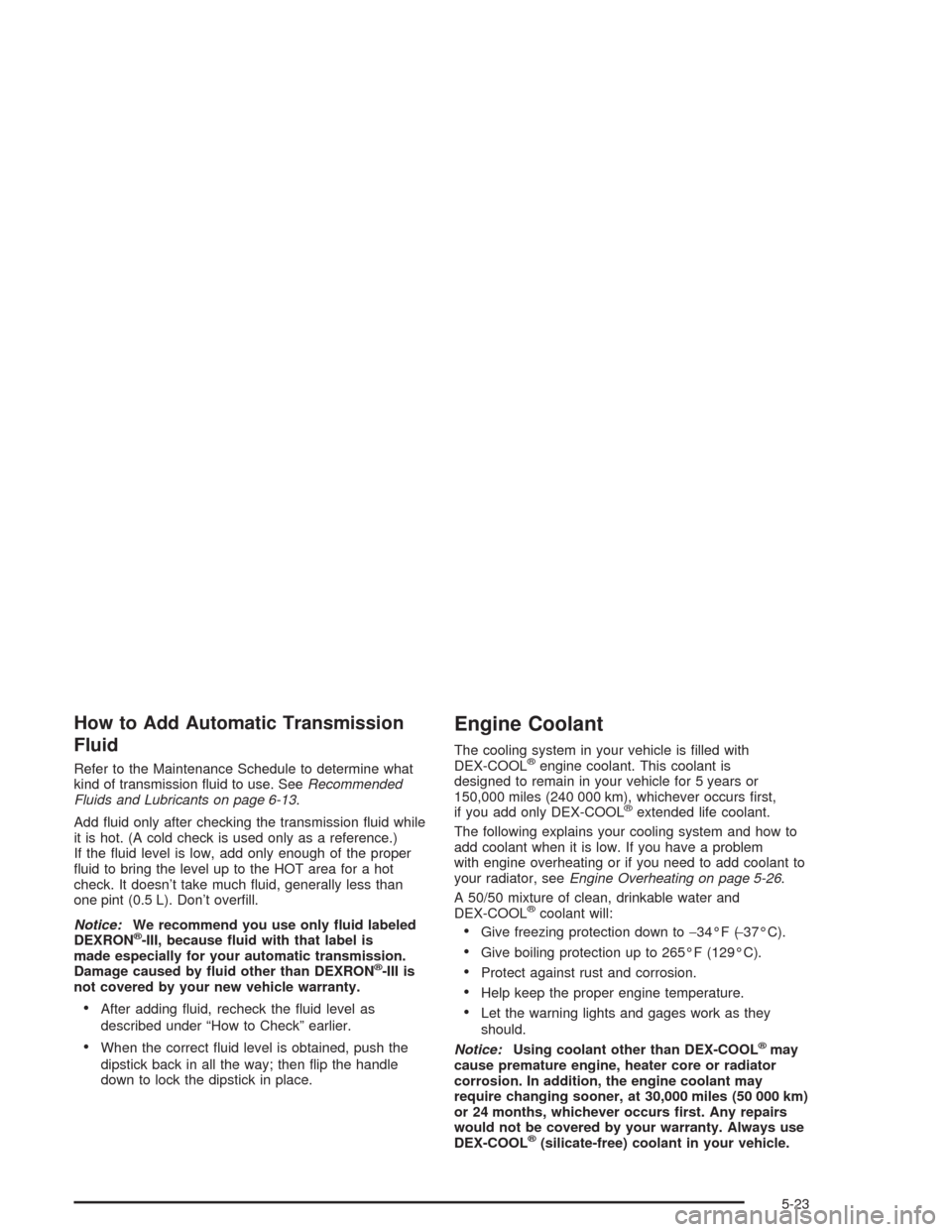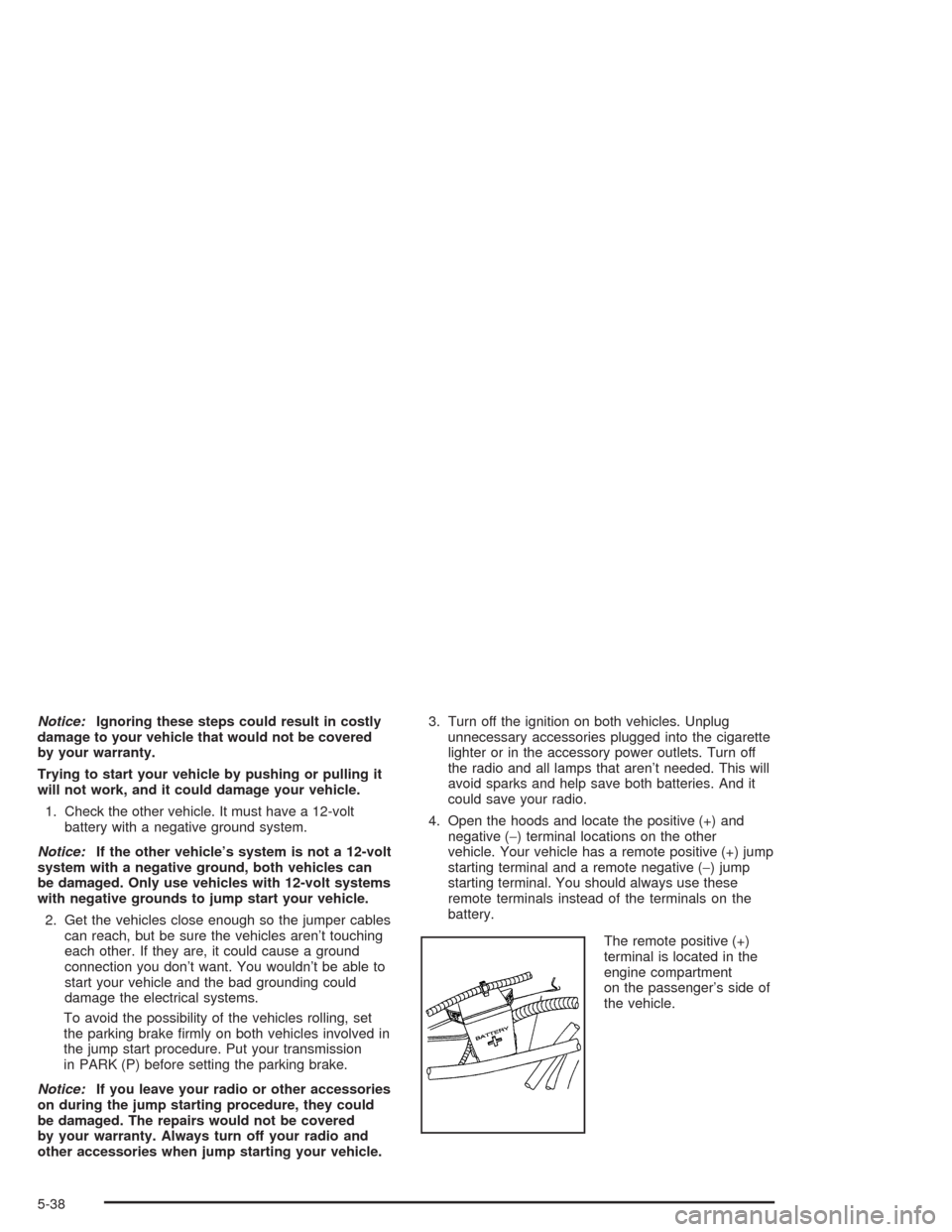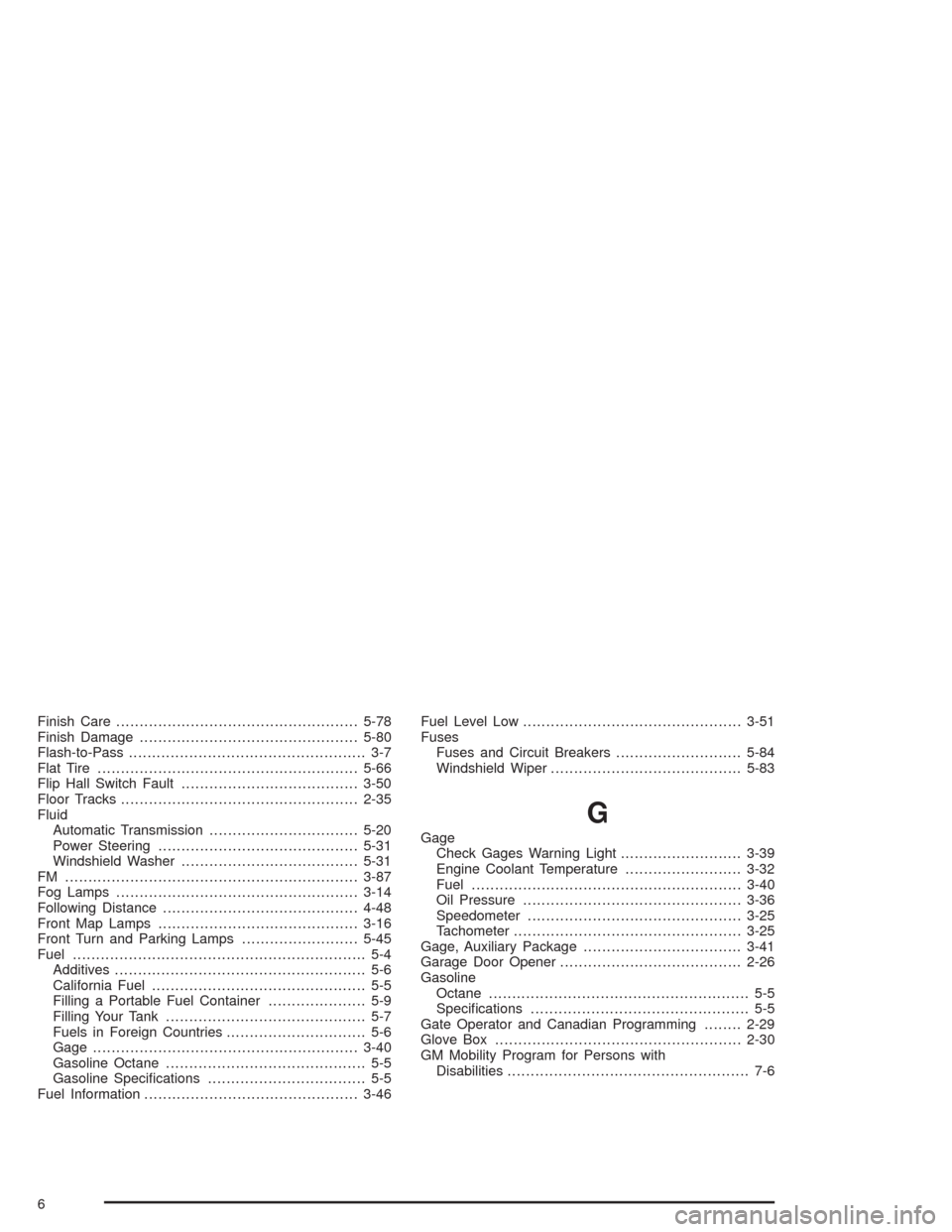check engine light CHEVROLET SSR 2004 1.G User Guide
[x] Cancel search | Manufacturer: CHEVROLET, Model Year: 2004, Model line: SSR, Model: CHEVROLET SSR 2004 1.GPages: 398, PDF Size: 2.49 MB
Page 167 of 398

Fuel Level Low
If the fuel level is low in the vehicle’s gas tank this
message will appear on the DIC and you will hear a
chime. You will also see the check gages warning light
on the instrument panel cluster. SeeCheck Gages
Warning Light on page 3-39for more information. Refuel
as soon as possible. SeeFilling Your Tank on page 5-7
andFuel Gage on page 3-40for more information.
Press the select button to acknowledge and clear the
message from the display.
Hdr (Header) Latch Switch Fault
This message will be displayed on the DIC when trying
to raise or lower the convertible top and there is a
fault with this switch. If the message persists, see your
dealer for service.
Manually Open Tonneau
This message will be displayed on the DIC when trying
to raise or lower the convertible top while the
convertible top and roof tonneau are where the system
cannot verify their position. The roof system may
need to be restored manually to a stable position by
fully opening the roof tonneau and boot cover panel. See
Convertible Top on page 2-45for more information.
Oil Pressure Low Stop Engine
{CAUTION:
Do not keep driving if the oil pressure is low. If
you do, your engine can become so hot that it
catches �re. You or others could be burned.
Check your oil as soon as possible and have
your vehicle serviced.
Notice:Lack of proper engine oil maintenance may
damage the engine. The repairs would not be
covered by your warranty. Always follow the
maintenance schedule in this manual for changing
engine oil.
If the oil pressure is low in your vehicle, this message
will be displayed on the DIC. Stop the vehicle as
soon as possible and do not drive it until the cause of
the low oil pressure has been corrected. Check your oil
as soon as possible and have your vehicle serviced.
SeeEngine Oil on page 5-13andOil Pressure Gage on
page 3-36for more information.
3-51
Page 211 of 398

Avoid needless heavy braking. Some people drive
in spurts — heavy acceleration followed by heavy
braking — rather than keeping pace with traffic. This is
a mistake. Your brakes may not have time to cool
between hard stops. Your brakes will wear out much
faster if you do a lot of heavy braking. If you keep pace
with the traffic and allow realistic following distances,
you will eliminate a lot of unnecessary braking.
That means better braking and longer brake life.
If your engine ever stops while you are driving, brake
normally but do not pump your brakes. If you do,
the pedal may get harder to push down. If your engine
stops, you will still have some power brake assist.
But you will use it when you brake. Once the power
assist is used up, it may take longer to stop and
the brake pedal will be harder to push.Anti-lock Brake System
Your vehicle has anti-lock brakes. ABS is an advanced
electronic braking system that will help prevent a
braking skid.
When you start your engine and begin to drive away,
your anti-lock brake system will check itself. You
may hear a momentary motor or clicking noise while
this test is going on. This is normal.
If there is a problem with
the anti-lock brake system,
this warning light will
stay on. SeeAnti-Lock
Brake System Warning
Light on page 3-31.
4-7
Page 234 of 398

You can run the engine to keep warm, but be careful.
{CAUTION:
Snow can trap exhaust gases under your
vehicle. This can cause deadly CO (carbon
monoxide) gas to get inside. CO could
overcome you and kill you. You can not see it
or smell it, so you might not know it is in your
vehicle. Clear away snow from around the
base of your vehicle, especially any that is
blocking your exhaust pipe. And check around
again from time to time to be sure snow does
not collect there.
Open a window just a little on the side of the
vehicle that is away from the wind. This will
help keep CO out.Run your engine only as long as you must. This saves
fuel. When you run the engine, make it go a little
faster than just idle. That is, push the accelerator
slightly. This uses less fuel for the heat that you get and
it keeps the battery charged. You will need a
well-charged battery to restart the vehicle, and possibly
for signaling later on with your headlamps. Let the
heater run for a while.
Then, shut the engine off and close the window almost
all the way to preserve the heat. Start the engine
again and repeat this only when you feel really
uncomfortable from the cold. But do it as little as
possible. Preserve the fuel as long as you can. To help
keep warm, you can get out of the vehicle and do
some fairly vigorous exercises every half hour or so until
help comes.
4-30
Page 272 of 398

Notice:Use only engine oil identi�ed as meeting
GM Standard GM6094M and showing the American
Petroleum Institute Certi�ed For Gasoline Engines
starburst symbol. Failure to use the recommended
oil can result in engine damage not covered by
your warranty.
GM Goodwrench
®oil meets all the requirements for
your vehicle.
If you are in an area of extreme cold, where the
temperature falls below−20°F (−29°C), it is
recommended that you use either an SAE 5W-30
synthetic oil or an SAE 0W-30 oil. Both will provide
easier cold starting and better protection for your engine
at extremely low temperatures.
Engine Oil Additives
Do not add anything to your oil. The recommended oils
with the starburst symbol that meet GM Standard
GM6094M are all you will need for good performance
and engine protection.
When to Change Engine Oil
(GM Oil Life System)
Your vehicle has a computer system that lets you know
when to change the engine oil and �lter. This is based on
engine revolutions and engine temperature, and not on
mileage. Based on driving conditions, the mileage at
which an oil change will be indicated can vary
considerably. For the oil life system to work properly, you
must reset the system every time the oil is changed.
When the system has calculated that oil life has been
diminished, it will indicate that an oil change is
necessary. A change engine oil light will come on.
Change your oil as soon as possible within the next two
times you stop for fuel. It is possible that, if you are
driving under the best conditions, the oil life system may
not indicate that an oil change is necessary for over a
year. However, your engine oil and �lter must be
changed at least once a year and at this time the system
must be reset. Your dealer has GM-trained service
people who will perform this work using genuine
GM parts and reset the system. It is also important to
check your oil regularly and keep it at the proper level.
If the system is ever reset accidentally, you must
change your oil at 3,000 miles (5 000 km) since your
last oil change. Remember to reset the oil life system
whenever the oil is changed.
5-16
Page 279 of 398

How to Add Automatic Transmission
Fluid
Refer to the Maintenance Schedule to determine what
kind of transmission �uid to use. SeeRecommended
Fluids and Lubricants on page 6-13.
Add �uid only after checking the transmission �uid while
it is hot. (A cold check is used only as a reference.)
If the �uid level is low, add only enough of the proper
�uid to bring the level up to the HOT area for a hot
check. It doesn’t take much �uid, generally less than
one pint (0.5 L). Don’t over�ll.
Notice:We recommend you use only �uid labeled
DEXRON
®-III, because �uid with that label is
made especially for your automatic transmission.
Damage caused by �uid other than DEXRON
®-III is
not covered by your new vehicle warranty.
After adding �uid, recheck the �uid level as
described under “How to Check” earlier.
When the correct �uid level is obtained, push the
dipstick back in all the way; then �ip the handle
down to lock the dipstick in place.
Engine Coolant
The cooling system in your vehicle is �lled with
DEX-COOL®engine coolant. This coolant is
designed to remain in your vehicle for 5 years or
150,000 miles (240 000 km), whichever occurs �rst,
if you add only DEX-COOL
®extended life coolant.
The following explains your cooling system and how to
add coolant when it is low. If you have a problem
with engine overheating or if you need to add coolant to
your radiator, seeEngine Overheating on page 5-26.
A 50/50 mixture of clean, drinkable water and
DEX-COOL
®coolant will:
Give freezing protection down to−34°F (−37°C).
Give boiling protection up to 265°F (129°C).
Protect against rust and corrosion.
Help keep the proper engine temperature.
Let the warning lights and gages work as they
should.
Notice:Using coolant other than DEX-COOL
®may
cause premature engine, heater core or radiator
corrosion. In addition, the engine coolant may
require changing sooner, at 30,000 miles (50 000 km)
or 24 months, whichever occurs �rst. Any repairs
would not be covered by your warranty. Always use
DEX-COOL
®(silicate-free) coolant in your vehicle.
5-23
Page 294 of 398

Notice:Ignoring these steps could result in costly
damage to your vehicle that would not be covered
by your warranty.
Trying to start your vehicle by pushing or pulling it
will not work, and it could damage your vehicle.
1. Check the other vehicle. It must have a 12-volt
battery with a negative ground system.
Notice:If the other vehicle’s system is not a 12-volt
system with a negative ground, both vehicles can
be damaged. Only use vehicles with 12-volt systems
with negative grounds to jump start your vehicle.
2. Get the vehicles close enough so the jumper cables
can reach, but be sure the vehicles aren’t touching
each other. If they are, it could cause a ground
connection you don’t want. You wouldn’t be able to
start your vehicle and the bad grounding could
damage the electrical systems.
To avoid the possibility of the vehicles rolling, set
the parking brake �rmly on both vehicles involved in
the jump start procedure. Put your transmission
in PARK (P) before setting the parking brake.
Notice:If you leave your radio or other accessories
on during the jump starting procedure, they could
be damaged. The repairs would not be covered
by your warranty. Always turn off your radio and
other accessories when jump starting your vehicle.3. Turn off the ignition on both vehicles. Unplug
unnecessary accessories plugged into the cigarette
lighter or in the accessory power outlets. Turn off
the radio and all lamps that aren’t needed. This will
avoid sparks and help save both batteries. And it
could save your radio.
4. Open the hoods and locate the positive (+) and
negative (−) terminal locations on the other
vehicle. Your vehicle has a remote positive (+) jump
starting terminal and a remote negative (−) jump
starting terminal. You should always use these
remote terminals instead of the terminals on the
battery.
The remote positive (+)
terminal is located in the
engine compartment
on the passenger’s side of
the vehicle.
5-38
Page 352 of 398

Owner Checks and Services on page 6-9tells you what
should be checked, when to check it and what you
can easily do to help keep your vehicle in good
condition.
The proper replacement parts, �uids and lubricants to
use are listed inRecommended Fluids and Lubricants
on page 6-13andNormal Maintenance Replacement
Parts on page 6-15. When your vehicle is serviced,
make sure these are used. All parts should be replaced
and all necessary repairs done before you or anyone
else drives the vehicle. We recommend the use of
genuine GM parts.
Scheduled Maintenance
When the CHANGE ENGINE OIL light comes on, it
means that service is required for your vehicle. Have
your vehicle serviced as soon as possible within the next
600 miles (1 000 km). It is possible that, if you are
driving under the best conditions, the engine oil
life system may not indicate that vehicle service is
necessary for over a year. However, your engine oil and
�lter must be changed at least once a year and at
this time the system must be reset. Your GM
Goodwrench dealer has GM-trained service technicians
who will perform this work using genuine GM parts
and reset the system.If the engine oil life system is ever reset accidentally,
you must service your vehicle within 3,000 miles
(5 000 km) since your last service. Remember to reset
the oil life system whenever the oil is changed. See
Engine Oil on page 5-13for information on the Engine
Oil Life System and resetting the system.
When the CHANGE ENGINE OIL light appears, certain
services, checks and inspections are required.
Required services are described in the following for
“MaintenanceI” and “MaintenanceII.” Generally,
it is recommended that your �rst service be
MaintenanceI, your second service be MaintenanceII
and that you alternate MaintenanceIand MaintenanceII
thereafter. However, in some cases, MaintenanceII
may be required more often.
MaintenanceI— Use MaintenanceIif the CHANGE
ENGINE OIL light comes on within ten months since
vehicle was purchased or MaintenanceIIwas
performed.
MaintenanceII— Use MaintenanceIIif the previous
service performed was MaintenanceI. Always use
MaintenanceIIwhenever the light comes on ten months
or more since the last service or if the light has not
come on at all for one year.
6-4
Page 385 of 398

Center High-Mounted Stoplamp (CHMSL)...........5-47
Certi�cation/Tire Label.....................................4-36
Chains, Tires..................................................5-65
Change Trans (Transmission) Fluid....................3-49
Charging System Light....................................3-29
Check
Engine Light...............................................3-32
Gages Warning Light...................................3-39
Check Engine Light.........................................3-32
Check Oil Level..............................................3-49
Checking Brake Fluid......................................5-34
Checking Coolant............................................5-25
Checking Engine Oil........................................5-13
Checking the Automatic Transmission
Fluid Level.................................................5-21
Checking Things Under the Hood......................5-10
Chemical Paint Spotting...................................5-80
Child Restraints
Child Restraint Systems...............................1-27
Infants and Young Children...........................1-24
Lower Anchorages and Top Tethers for
Children (LATCH System)..........................1-32
Older Children.............................................1-21
Securing a Child Restraint Designed for the
LATCH System........................................1-34Child Restraints (cont.)
Securing a Child Restraint in the
Passenger Seat Position...........................1-37
Top Strap...................................................1-30
Top Strap Anchor Location............................1-32
Cigarette Lighter.............................................3-18
Cleaning
Inside of Your Vehicle..................................5-74
Outside of Your Vehicle................................5-77
Underbody Maintenance...............................5-80
Weatherstrips..............................................5-77
Cleaning Aluminum or Chrome-Plated Wheels.....5-79
Cleaning Exterior Lamps/Lenses.......................5-78
Cleaning Fabric/Carpet....................................5-74
Cleaning Glass Surfaces..................................5-76
Cleaning Interior Plastic Components.................5-76
Cleaning Leather............................................5-76
Cleaning the Top of the Instrument Panel...........5-76
Cleaning the Windshield and Wiper Blades.........5-79
Cleaning Tires................................................5-80
Cleaning Vinyl................................................5-76
Climate Control System...................................3-19
Outlet Adjustment........................................3-22
Content Theft-Deferrent....................................2-11
3
Page 387 of 398

Driving On Grades..........................................4-50
Driving on Snow or Ice....................................4-27
Driving Through Deep Standing Water...............4-19
Driving Through Flowing Water.........................4-19
Driving with a Trailer.......................................4-48
Brake Pedal Travel.........................................5-35
E
Electrical System
Add-On Equipment......................................5-83
Fuses and Circuit Breakers...........................5-84
Headlamps.................................................5-83
Power Windows and Other Power Options......5-83
Windshield Wiper Fuses...............................5-83
Emergency Cargo Cover Release Handle...........2-34
Emissions Inspection and
Maintenance Programs.................................3-35
Engine
Air Cleaner/Filter.........................................5-19
Battery.......................................................5-36
Change Engine Oil Light...............................3-37
Check and Service Engine Soon Light............3-32
Coolant......................................................5-23
Coolant Temperature Gage...........................3-32
Cover........................................................5-18
Drive Belt Routing.......................................6-16Engine (cont.)
Engine Compartment Overview......................5-12
Exhaust.....................................................2-21
Oil .............................................................5-13
Overheating................................................5-26
Reduced Power Light...................................3-38
Starting......................................................2-15
Engine Compartment Fuse Block......................5-87
Engine Coolant Hot Idle Engine........................3-50
Engine Cover Insert........................................5-18
Engine Oil Additives........................................5-16
Engine Overheated Stop Engine.......................3-50
Erasing HomeLink
®Buttons..............................2-29
Event Data Recorders (EDR)............................7-10
Exit Lighting...................................................3-16
Express Down Window....................................2-10
Extender, Safety Belt.......................................1-20
Exterior Lamps...............................................3-12
F
Fan Knob......................................................3-20
Filter
Engine Air Cleaner......................................5-19
Finding a Program Type (PTY) Station.......3-65, 3-75
Finding a Station....................................3-63, 3-72
5
Page 388 of 398

Finish Care....................................................5-78
Finish Damage...............................................5-80
Flash-to-Pass................................................... 3-7
Flat Tire........................................................5-66
Flip Hall Switch Fault......................................3-50
Floor Tracks...................................................2-35
Fluid
Automatic Transmission................................5-20
Power Steering...........................................5-31
Windshield Washer......................................5-31
FM ...............................................................3-87
Fog Lamps....................................................3-14
Following Distance..........................................4-48
Front Map Lamps...........................................3-16
Front Turn and Parking Lamps.........................5-45
Fuel............................................................... 5-4
Additives...................................................... 5-6
California Fuel.............................................. 5-5
Filling a Portable Fuel Container..................... 5-9
Filling Your Tank........................................... 5-7
Fuels in Foreign Countries.............................. 5-6
Gage.........................................................3-40
Gasoline Octane........................................... 5-5
Gasoline Speci�cations.................................. 5-5
Fuel Information..............................................3-46Fuel Level Low...............................................3-51
Fuses
Fuses and Circuit Breakers...........................5-84
Windshield Wiper.........................................5-83
G
Gage
Check Gages Warning Light..........................3-39
Engine Coolant Temperature.........................3-32
Fuel..........................................................3-40
Oil Pressure...............................................3-36
Speedometer..............................................3-25
Tachometer.................................................3-25
Gage, Auxiliary Package..................................3-41
Garage Door Opener.......................................2-26
Gasoline
Octane........................................................ 5-5
Speci�cations............................................... 5-5
Gate Operator and Canadian Programming........2-29
Glove Box.....................................................2-30
GM Mobility Program for Persons with
Disabilities.................................................... 7-6
6